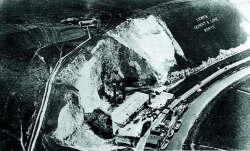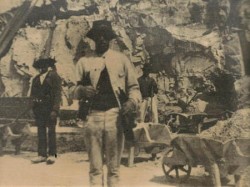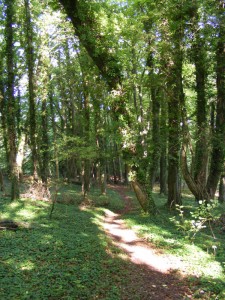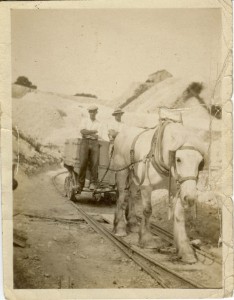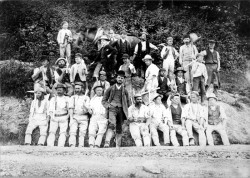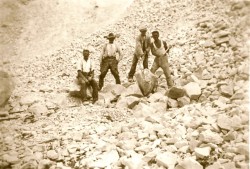It’s hard to imagine that the tranquil Downs we see today were once a hive of industry. In the late 19th and early 20th century, hundreds of men were employed quarrying chalk from the slopes. This was then burnt in kilns to make lime, which was used in the manufacture of cement, as a soil improver in agriculture and to help soften drinking water.
You can take a step back in history at several locations in the South Downs to discover the heritage of the chalk industry.
The Amberley Museum and heritage centre is sited in the old Amberley Chalk pit and the Museum contains chalk pits, kilns and buildings from this once important industry.
The chalk pits at Buriton have been saved by Heritage Lottery Funding and the hard work of a lot of volunteers. New trails describe the history of the area and give you hints to spot the remains of the quarrying activity. It is now also a rich habitat with a high level of chalk-based species. The site has been designated both a Site of Importance for Nature Conservation (SINC) and a Local Nature Reserve.
The new YHA South Downs hostel at Itford farm near Southease station has just opened. It offers great accommodation to explore the South Downs National Park and includes a café and education room that celebrates the heritage of chalk workers in the area.
At the Chalk Pit Inn, Offham you can sup a beer in the pub which once was the Offham chalk pit at the centre of a chalk pit famous for it’s funicular railway. The area has a range of walking trails to help you explore the area with the local history society supporting the school to connect with the local history. The proximity of the River Ouse to the Chalk Downs which gave rise to this once thriving industry where the river itself became vital for transport. There are more chalk pits on the banks of the River Ouse than anywhere else in Europe.
Resources Toolbox
General Interest
All Ages
-

Buriton Chalk Pit Industrial History Trail
A walk around the site of the old lime workings and now a Local Nature Reserve. Information on the key features that highlight the history of the site. -

Buriton Chalk Pit Industrial Nature Trail
A walk around the site of the old lime workings and now a Local Nature Reserve. Information on the wildlife that lives in this a rich chalk habitat. -

Buriton Chalk Pits Information
A presentation of images, maps and information about Buriton Chalk pits. More info in accompnaying Teachers Notes. -

Buriton Chalk Pits Information teachers notes
Teachers Notes for the presentation of images, maps and information about Buriton Chalk pits. -

Offham Chalk Pit Information
Information about the old disused chalk pit at Chalk Pit Inn, Offham, East Sussex.
Key Stage 1
Ages 5–7
Years 1 and 2
Key Stage 2
Ages 7–11
Years 3, 4, 5 and 6
-

Buriton Chalk Pit Industrial History Trail
A walk around the site of the old lime workings and now a Local Nature Reserve. Information on the key features that highlight the history of the site. -

Buriton Chalk Pit Industrial Nature Trail
A walk around the site of the old lime workings and now a Local Nature Reserve. Information on the wildlife that lives in this a rich chalk habitat. -

Buriton Chalk Pits Information
A presentation of images, maps and information about Buriton Chalk pits. More info in accompnaying Teachers Notes. -

Buriton Chalk Pits Information teachers notes
Teachers Notes for the presentation of images, maps and information about Buriton Chalk pits. -

Chalk Grassland Super Species
A set of 13 top trumps style cards with images and information about chalk grassland specialist species.
Key Stage 3
Ages 11–14
Years 7, 8 and 9
-

Buriton Chalk Pit Industrial History Trail
A walk around the site of the old lime workings and now a Local Nature Reserve. Information on the key features that highlight the history of the site. -

Buriton Chalk Pit Industrial Nature Trail
A walk around the site of the old lime workings and now a Local Nature Reserve. Information on the wildlife that lives in this a rich chalk habitat. -

Buriton Chalk Pits Information
A presentation of images, maps and information about Buriton Chalk pits. More info in accompnaying Teachers Notes. -

Buriton Chalk Pits Information teachers notes
Teachers Notes for the presentation of images, maps and information about Buriton Chalk pits. -

Chalk Grassland Super Species
A set of 13 top trumps style cards with images and information about chalk grassland specialist species.
Key Stage 4
Ages 14–16
Years 10 and 11
-

Buriton Chalk Pit Industrial History Trail
A walk around the site of the old lime workings and now a Local Nature Reserve. Information on the key features that highlight the history of the site. -

Buriton Chalk Pit Industrial Nature Trail
A walk around the site of the old lime workings and now a Local Nature Reserve. Information on the wildlife that lives in this a rich chalk habitat. -

Buriton Chalk Pits Information
A presentation of images, maps and information about Buriton Chalk pits. More info in accompnaying Teachers Notes. -

Buriton Chalk Pits Information teachers notes
Teachers Notes for the presentation of images, maps and information about Buriton Chalk pits.


